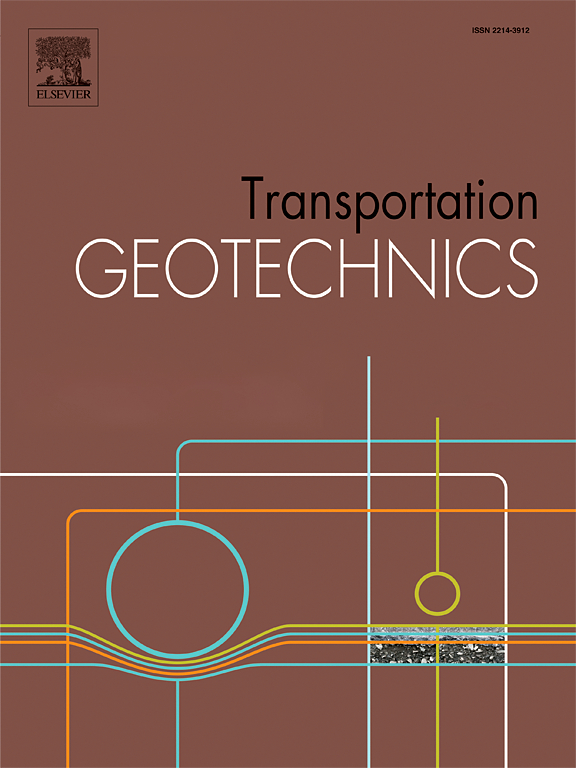基于多源数据的喀斯特地区铁路沿线地表变形监测与预测——以中国京广铁路为例
IF 4.9
2区 工程技术
Q1 ENGINEERING, CIVIL
引用次数: 0
摘要
岩溶塌陷严重影响铁路的安全运行。识别铁路沿线失稳目标区并捕捉其变形趋势是控制铁路沿线失稳目标区最有效的方法之一。然而,传统的铁路沿线变形监测分析方法过于单一,导致无法进行变形的综合识别和提前预测。为此,提出了一种利用多源数据对喀斯特地区铁路沿线地表变形进行监测和预测的方法。以京广铁路广州段为例,首先采用“空-空-地”多源手段对铁路沿线的危害及邻近的人类工程活动进行监测。其次,以时间序列变形值为数据基础,采用小波变换(WT)算法对三个历史路基岩溶塌陷点的时间序列变形噪声进行降噪处理;采用五种经典的机器学习模型对变形进行预测分析,并利用最优的机器学习模型进行预测。结果表明:①铁路沿线有两个沉降目地,2021-2023年沉降范围不断扩大,累积沉降量逐年增加,最大累积沉降量为- 118.01 mm;②2019 - 2023年A区特征点持续下沉,最大累积沉降量为- 108.01 mm;2021年至2023年6月,受周边项目干扰,B区特征点持续下沉。3)通过预测分析,WT-LSTM的预测效果是最优的,在超前预测结果的基础上,未来变形预测的尺度在1年左右。研究成果可为铁路沿线沉降灾害的识别和早期防治提供关键技术支持。本文章由计算机程序翻译,如有差异,请以英文原文为准。
Monitoring and prediction of surface deformation along railways lines in karst areas using multi-source data − a case study of the Beijing-Guangzhou Railway in China
The Karst collapse seriously affects the safe operation of railways. Identifying the instability target areas along the railway and capturing its deformation trend is one of the most effective methods for controlling this hazard. However, the traditional methods of monitoring and analyzing deformation along the railway line are too single, resulting in the inability to carry out comprehensive identification of deformation and advance prediction. Hence, a method using multi-source data is proposed to monitor and predict surface deformation along railway lines in karst areas. Taking the Guangzhou part of the Beijing-Guangzhou Railway in China as an example, the hazards and adjacent human engineering activities along the railway are monitored by using multi-source means of “Space-Air-Ground” at first. Secondly, taking the time-series deformation values as the data basis, the wavelet transform (WT) algorithm is used to reduce the noise of the time-series deformation in the three historical subgrade karst collapse points. Five classical machine learning (ML) models are used for the prediction analysis of the deformation, and the optimal ML model is utilized to advance prediction. The results show: 1) There are two settlement target areas along the railway, and the settlement range is expanding and the cumulative settlement increases year by year in 2021–2023, with the maximum cumulative settlement of −118.01 mm. 2) The characteristic points in Area A continue to sink from 2019 to 2023, with a maximum cumulative settlement of −108.01 mm. The characteristic points in Area B continue to sink from 2021 to June 2023 due to disturbance from adjacent projects. 3) The prediction effect of the WT-LSTM is optimal through prediction analysis, and the scale of future deformation prediction is about one year based on the results of the advance prediction. The research findings can provide key technical support for the identification and early prevention of settlement hazards along railways.
求助全文
通过发布文献求助,成功后即可免费获取论文全文。
去求助
来源期刊

Transportation Geotechnics
Social Sciences-Transportation
CiteScore
8.10
自引率
11.30%
发文量
194
审稿时长
51 days
期刊介绍:
Transportation Geotechnics is a journal dedicated to publishing high-quality, theoretical, and applied papers that cover all facets of geotechnics for transportation infrastructure such as roads, highways, railways, underground railways, airfields, and waterways. The journal places a special emphasis on case studies that present original work relevant to the sustainable construction of transportation infrastructure. The scope of topics it addresses includes the geotechnical properties of geomaterials for sustainable and rational design and construction, the behavior of compacted and stabilized geomaterials, the use of geosynthetics and reinforcement in constructed layers and interlayers, ground improvement and slope stability for transportation infrastructures, compaction technology and management, maintenance technology, the impact of climate, embankments for highways and high-speed trains, transition zones, dredging, underwater geotechnics for infrastructure purposes, and the modeling of multi-layered structures and supporting ground under dynamic and repeated loads.
 求助内容:
求助内容: 应助结果提醒方式:
应助结果提醒方式:


